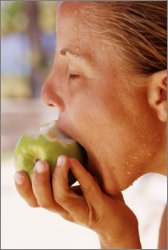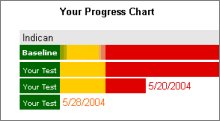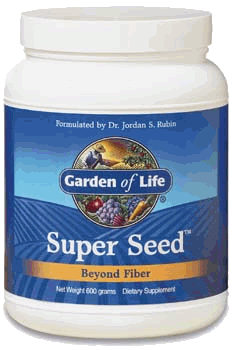Appendicitis: What It Is & How to Prevent
This Way-Too-Common Killer
by www.SixWise.com
Most people don't give a second thought to their appendix -- that is unless it's causing them severe pain. This is an indication of appendicitis, which is an inflammation of the appendix that is surprisingly common in the United States -- about one in 15 people will get appendicitis during their lifetime.
|

Appendicitis is most common between the ages of 10 and 30.
|
What is the Appendix, and What Does it Do?
You appendix is a 3-1/2 inch long finger-shaped pouch that extends from your large intestine, on the lower right side of your abdomen. Although it used to be thought that your appendix has no real purpose, last year researchers discovered that it actually produces good bacteria and helps protect good bacteria in your gut.
This is especially important if you were to be infected with an illness that killed off most of your friendly bacteria, such as cholera or dysentery. In these cases, your appendix restores your body's supply of good bacteria.
"We propose that the human appendix is well suited as a "safe house" for commensal bacteria, providing support for bacterial growth and potentially facilitating re-inoculation of the colon in the event that the contents of the intestinal tract are purged following exposure to a pathogen," the researchers wrote in the Journal of Theoretical Biology.
How Does Appendicitis Happen?
Appendicitis occurs when your appendix becomes inflamed and filled with pus. About 321,000 Americans are hospitalized with appendicitis each year, and 300 to 400 die, according to the Centers for Disease Control and Prevention.
Though it can occur at any age, appendicitis is most common between the ages of 10 and 30.
Often, the exact cause of the condition is not known, but appendicitis can occur due to an obstruction (a piece of food or hard waste) in your appendix or an infection. Either way, bacteria can rapidly invade your appendix, causing it to become severely inflamed.
|

Eating lots of high-fiber foods like apples, pears, seeds, nuts and oatmeal may help reduce your risk of appendicitis.
|
This results in pain in your navel and lower right abdomen, which grows more severe over a period of six to 12 hours. Often, if you put pressure on the area the pain will feel worse after you take the pressure off. Coughing, walking and other abrupt movements also tend to make the pain more severe. Aside from pain, appendicitis may cause:
-
Nausea and vomiting
-
Loss of appetite
-
Low-grade fever
-
Diarrhea or constipation
-
Abdominal swelling
-
An inability to pass gas
-
Painful urination
If you feel these symptoms it's essential to get help right away as your appendix may rupture, causing life-threatening complications. Specifically, a ruptured appendix allows the contents of your intestines and infectious organisms to invade your abdominal cavity, according to the Mayo Clinic. This can lead to a very serious infection of the lining of this cavity, a condition known as peritonitis.
Typically, appendicitis is treated by having emergency surgery to remove your appendix before it ruptures (known as an appendectomy).
Natural Methods to Reduce Your Risk of Appendicitis
Studies show that people who eat foods high in fiber, including plenty of fresh fruits and vegetables, are less likely to get appendicitis.
|
Become Empowered:
Chart Your Health

Do you want to:
-
Find out the actual nutritional deficiencies that exist in your body, right now?
-
Be empowered to do something positive for your health?
-
Receive customized recommendations for dietary supplements and meal plans?
United Medical Network will chart your current health state and provide you with a customized solution.
Start Charting
Your Health Now!
|
There are numerous fiber-rich foods out there, including:
Soluble Fiber
-
Apples
-
Oranges
-
Pears
-
Peaches
-
Grapes
-
Prunes
-
Blueberries
-
Strawberries
-
Seeds and Nuts
-
Oat bran
-
Dried beans
-
Oatmeal
-
Barley
-
Rye
-
Vegetables
Insoluble Fiber
If you'd like to get more fiber in your diet, but are concerned you're not getting enough from foods such as these, you should definitely consider trying the top-recommended Super Seed: Beyond Fiber, a powerful whole-food formula that supplies your body with a highly usable, nutrient-dense, vegetarian source of dietary fiber from flax seed, chia seed, sprouted quinoa, sprouted amaranth, pumpkin seed, sunflower seed, sesame seed, millet, buckwheat, fiber from garbanzo, red lentil, kidney and adzuki beans.
You can also try these 10 tips for creating a high-fiber diet:
-
Eat fewer processed foods and more fresh ones.
-
Eat high-fiber cereal for breakfast (one with bran or fiber in the name, not highly processed varieties), or add some unprocessed wheat bran to yogurt.
-
Snack on fruits and raw vegetables. For unique, tasty and FAST recipe ideas featuring raw foods, Alive in 5: Raw Gourmet Meals in Five Minutes is unbeatable.
-
Add ground flaxseeds and other seeds to smoothies.
|

Snacking on fruits and vegetables is an easy way to make your diet a high-fiber one. But if getting enough fiber in your diet is a challenge for you, we highly recommend you consider Super Seed: Beyond Fiber described above.
|
-
Use bran products as toppings for casseroles, meatloaf, veggies and more.
-
Eat whole-grain breads and substitute whole-grain flour for white flour.
-
Add beans to soups, salads and chili.
-
Eat whole fruits (including the skin and membranes) instead of drinking fruit juice.
-
Use brown rice and whole-grain pasta instead of white rice and pasta.
-
Try international dishes that include high-fiber foods (tabbouleh or Indian dahls, for example).
Recommended Reading
The Top 15 Signs of Heart Disease Everyone Needs to Know
Does Organ Harvesting Really Exist?
Sources
Journal of Theoretical Biology Volume 249, Issue 4, 21 December 2007, Pages 826-831
MSNBC.com October 5, 2007
MayoClinic.com Appendicitis
WebMD.com Digestive Disorders Health Center